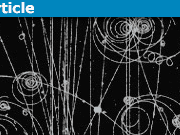How I Stopped Worrying and Learned to Love Orthodox Quantum Mechanics
Many people here know that I am a “Bohmian”, i.e. an adherent of a very non-orthodox interpretation of quantum mechanics (QM). Indeed, in the past, I have published a lot of papers on Bohmian mechanics in peer-reviewed journals from 2004 to 2012. So how can I not worry and love orthodox QM? As a “Bohmian”, shouldn’t I be strictly against orthodox QM?
No. If by orthodox QM, one means instrumental QM (which is well explained in the book “Quantum Theory: Concepts and Methods” by A. Peres), then orthodox QM is fully compatible with Bohmian QM. I am not saying that they are equivalent; indeed Bohmian QM offers answers to some questions on which instrumental QM has nothing to say. But I am saying that they are compatible, in the sense that no claim of instrumental QM contradicts any claim of Bohmian QM.
But still, if instrumental QM has nothing to say about certain questions, then why am I not worried? As a “Bohmian”, I certainly do not consider those questions irrelevant. So how can I not worry about it when it says nothing about questions that I find relevant?
The answer is that I stopped worrying and learned to love orthodox QM precisely because I know about Bohmian QM. But let me explain it from the beginning.
I always wanted to study the most fundamental aspects of physics. Consequently, as a student of physics, I was much more fascinated by topics such as particle physics and general relativity than about topics such as condensed-matter physics. Therefore, my graduate study in physics and my Ph.D. were in high-energy physics. Nevertheless, all the knowledge about quantum field theory (QFT) that I acquired as a high-energy physicist did not help me much to resolve one deep puzzle that really bothered me about QM. The thing that bothered me was how could Nature work like that? How could that possibly be? What could be a possible physical mechanism behind the abstract rules of QM? Should one conclude that there is no mechanism at all and that standard QM (including QFT) is the end of the story?
But then I learned about Bohmian QM, and that was a true revelation. It finally told me a possible story of how could that be. It didn’t definitely tell how it is (there is no direct evidence that Bohmian mechanics is how Nature actually works), but it did tell how it might be. It is comforting to know that behind the abstract and seemingly paradoxical formalism of QM may lie a simple intuitive mechanism as provided by Bohmian QM. Even if this mechanism is not exactly how Nature really works, the simple fact that such a mechanism is possible is sufficient to stop worrying and start to love instrumental QM as a useful tool that somehow emerges from a more fundamental mechanism, even if all the details of this mechanism are not (yet) known.
However, something important was still missing. Bohmian QM looks nice and simple for non-relativistic QM, but how about relativistic QFT? In principle, Bohmian ideas of that time worked also for relativistic QFT, but they did not look so nice and simple. My question was, can Bohmian ideas be modified such that it looks nice, simple and natural even for relativistic QFT? That question motivated my professional research on Bohmian QM and I published a lot of papers on that.
Nevertheless, I was not completely satisfied with my results. Even though I made several interesting modifications of Bohmian QM to incorporate relativistic QFT, neither of those modifications looked sufficiently simple and natural. Moreover, in arXiv:1309.0400, the last specialized paper on Bohmian mechanics I have written, a referee found a deep conceptual error that I was not able to fix. After that, I was no longer trying to modify Bohmian QM in that way.
Nevertheless, partial satisfaction came from a slightly different angle. In an attempt to make sense of local non-reality interpretation of QM, I developed a theory of solipsistic hidden variables which is a sort of a hybrid between Bohmian and Copenhagen QM. In this theory, an observer does play an important role, in the sense that Bohmian-like trajectories exist only for degrees of freedom of the observer and not for the observed objects. That theory helped me to learn that, in order to understand why do we observe what we observe, it is not necessary to know what exactly happens with observed objects. Instead, as solipsistic hidden variables demonstrate, in principle it can be understood even if the observed objects don’t exist! It was a big conceptual revelation for me that shaped my further thinking about the subject.
But it does not mean that I became a solipsist. I don’t believe that observed objects don’t exist. The important message is not that observed objects might not exist. The important message is that the exact nature of their existence is not really so important to explain their observation. That idea helped me a lot to stop worrying and learn to love orthodox QM.
But that was not the end. As I said, in my younger days, my way of thinking was largely shaped by high-energy physics and not by condensed-matter physics. I thought that condensed-matter physics cannot teach me much about the most fundamental problems in physics. But it started to change in 2010, when, by accident, I saw in Feynman Lectures on Physics that Bohmian mechanics is related to superconductivity (see here) That suddenly made me interested in superconductivity. But superconductivity cannot be understood without understanding other more basic aspects of condensed-matter physics, so gradually I became interested in condensed-matter physics as a field. One very interesting thing about condensed-matter physics is that it uses QFT formalism which is almost identical to QFT formalism in high-energy physics, but the underlying philosophy of QFT is very different. Condensed-matter physics taught me to think about QFT in a different way than I was used to as a high-energy physicist.
One of the main conceptual differences between the two schools of thought on QFT is the interpretation of particle-like excitations resulting from canonical quantization of fields. In high-energy physics, such excitations are typically interpreted as elementary particles. In condensed-matter physics, they are usually interpreted as quasiparticles, such as phonons. Since I was also a Bohmian, that led me to a natural question: Does it make sense to introduce a Bohmian trajectory of a phonon? An obvious (but somewhat superficial) answer is that it doesn’t make sense because only true particles, and not quasiparticles, are supposed to have Bohmian trajectories. But what is a “true” particle? What exactly does it mean that a photon is a “true” particle and a phonon isn’t?
It was this last question that led me to my last fundamental insight about Bohmian mechanics. As I explained in Sec. 4.3 of arXiv:1703.08341 (accepted for publication in Int. J. Quantum Inf.), the analogy with condensed-matter quasiparticles such as phonons suggests a very natural resolution of the problem of Bohmian interpretation of relativistic QFT. According to this resolution, the so-called “elementary” particles such as photons and electrons described by relativistic QFT are not elementary at all. Instead, they are merely quasiparticles, just as phonons. Consequently, those relativistic particles do not have Bohmian trajectories at all. What does have Bohmian trajectories are some more fundamental particles described by non-relativistic QM. Non-relativistic QM (together with Bohmian interpretation) is fundamental, while relativistic QFT is emergent. In this way, the problem of the Bohmian interpretation of relativistic QFT is circumvented in a very elegant way.
There is only one “little” problem with that idea. There is no experimental evidence that such more fundamental non-relativistic particles actually exist in Nature. Perhaps they will be discovered one day in the future, but at the moment it is only a theory. In fact, it is not even a proper theory, because it cannot tell anything more specific about the exact nature of those hypothetical non-relativistic particles.
Nevertheless, there are at least two good things about that. First, unlike most other versions of Bohmian mechanics, this version makes a testable prediction. It predicts that, at very small distances not yet accessible to experimental technology, Nature is made of non-relativistic particles. Second, at distances visible by current experimental technology, this version of Bohmian QM says that Bohmian trajectories are irrelevant. This means that, as far as relativistic QFT is concerned, I do not need to worry about Bohmian trajectories and can love orthodox QFT, without rejecting “common sense” in the form of non-relativistic Bohmian mechanics on some more fundamental scale. That’s how I finally I stopped worrying and learned to love orthodox QM.
Theoretical physicist from Croatia








Leave a Reply
Want to join the discussion?Feel free to contribute!